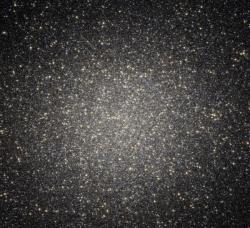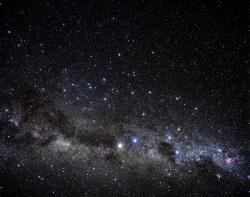Omega Centauri is a strange thing. It’s been classified as a star, then a nebula, then a globular cluster and now it’s thought to be a dwarf galaxy missing its outer stars. Why is it in such a mess? How can this oddball galaxy be explained? New research suggests it has an intermediate-black hole living in its core, giving astronomers the best idea yet as to where supermassive black holes come from. Omega Centauri might hold one of the most profound secrets as to how the largest objects in the observable universe are born…

Two thousand years ago, Omega Centauri was classified as a single star by Ptolemy. Edmond Halley studied this “star” but thought it looked a bit diffuse and re-classified it as a nebula in 1677. Then, in the 1830s, John Herschel was the first astronomer to realize this “nebula” was actually a galaxy, a globular cluster galaxy. But now, new observations by the Hubble Space Telescope (HST) reveal that this “globular cluster” isn’t what it seems… it’s actually a dwarf galaxy, stripped of its outer stars, some 17,000 light years away.
See an observation video zooming into the location of Omega Centauri in the constellation of Centaurus.
So what led to astronomers thinking there was something strange about this cosmic collection of stars? It rotates faster than other globular clusters, it is strangely flat and it contains stars of many generations (globular clusters usually contain stars of one generation). These reasons plus the fact Omega Centauri is ten times bigger than the largest globular clusters have led scientists to believe that this was no ordinary galaxy.
The main theory is that this unlucky galaxy may have crashed into the Milky Way in the distant past, shedding its outermost stars during the collision. This explains the lack of stars in its outer region. But why is it rotating so quickly, especially in the center?
These stunning images were taken by the NASA/ESA Hubble Space Telescope, which continues to do amazing science after 18 years in orbit. Combined with ground-based observations by the Gemini South telescope in Chile, astronomers have been able to deduce that a black hole may be at the root of a lot of the anomalies seen in Omega Centauri.
The research carried out at the Max-Planck Institute for Extraterrestrial Physics (in Garching, Germany), headed by Eva Noyola, shows stars near the center of Omega Centauri orbiting something very fast. In fact, this something is invisible for a reason. Calculating this invisible object’s mass, it is most likely that the group are observing an intermediate-size black hole with the mass of 40,000 solar masses. They have investigated other possibilities, perhaps the fast-orbiting stars could be accelerated by the collective mass of small, weakly radiating bodies such as white dwarves, or the orbiting stars’ have highly elliptical orbits and the point of closest approach is currently being observed, giving the impression they are going faster. However, the intermediate-size black hole theory appears to fit the situation far better.
This is a highly significant discovery, as so far there has been little linking the smaller, stellar black holes with the supermassive ones that sit in the center of large galaxies such as our own. There have been many theories put forward about how these huge black holes may have formed, but to find an intermediate-sized black hole may be the missing link and will help astrophysicists understand how supermassive black holes are “seeded” in the first place.
“This result shows that there is a continuous range of masses for black holes, from supermassive, to intermediate-mass, to small stellar mass types […] We may be on the verge of uncovering one possible mechanism for the formation of supermassive black holes. Intermediate-mass black holes like this could be the seeds of full-sized supermassive black holes.” – Eva Noyola.
Source: SpaceTelescope.org



I had not realized that there was some ambiguity as to the origins of mid-sized black holes as described in this article.
Just when you think you’ve got it all figured out……
Another terrific article…..well done.
“Allan Michael Says:
April 2nd, 2008 at 7:38 pm
I had not realized that there was some ambiguity as to the origins of mid-sized black holes as described in this article.”
There was another good article on IMBH’s in either Astronomy mag or Sky & Telescope mag not too long ago which is worth checking out if you’re interested…
Thank you Astrofiend (Syd, Aust)
Barring Hawking’s Radiation, isn’t it pretty clear that a small/medium sized black hole would continue to grow dependant on the influx of matter? What’s to stop a black hole from gaining mass if a star falls into it? Clearly (to me) the largest black holes are the oldest or the ones into which galaxies of stars have been sucked. What’s the supposed divisive factor between sizes of BH’s?
Doesn’t the largest black holes simply indicate more mass, and completely irrelevant to age? (to me) I can envision one of the earliest of black holes created, relatively modest size, renegade and slowly drifting between galaxies…looking for trouble…
Also, I find the the heading of the article a bit misleading – can you “observe” a black hole without photons hitting the retina?
Cheers!
Rusty… you talk about debate the cuestion… I wonder if ANY person want debate the war (you know what war I name) Debate is a democratic issue that our country has forget many years ago.
mmm sorry, that post was dreamed to other issue…
So the universe began as a microscopic point of infinate engergy. The inflation period created space/time lowering the energy density of the universe. Energy was able to manifest itself into particles that had the property of mass and gravity. Gravity distorts space/time by reducing local inflation pressure. Concentrate mass enough and the gravity creates a “drain” where mass becomes compressed into an infinately dense point of energy again. A small piece of what the universe started out as. Can another inflation event happen to this black hole or does all the energy in our universe have to be concentrated into one black hole again?
I am just a Dad trying to help a kid understand this.
Being from the southern climes (Tasmania)Omega Centauri is one of our most favourite deep space objects for viewing. When we have public viewing nights it is always guaranteed to get gasps of delight along with it’s brother/sister Tucanae 47.
What a great discovery about the true nature if this object it will only serve to increase the fascination.
A wonderful article!
The Omega Centauri globular cluste would then be to our Milky Way Galaxy what the dwarf elliptical NGC 205 (M110) is to the Andromeda Galaxy?
I would love to view it in a telescope.
I was wondering how long it would be before somebody found this particular black hole. It has always seemed like Omega Centauri was a prime candidate for a black hole. Congratulations to Eva Noyola and team. Well done.